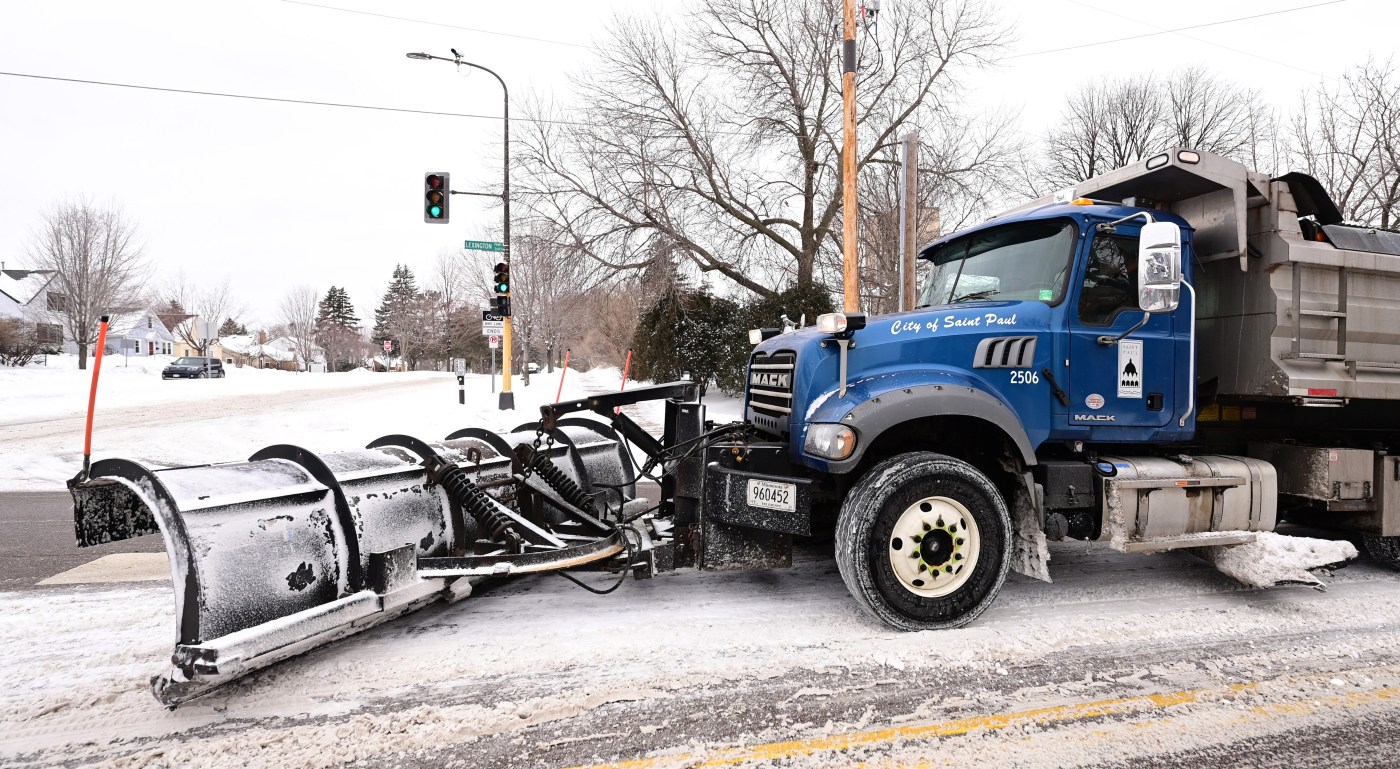
St. Paul’s two extreme winters prompt new look at snow emergencies
St. Paul’s municipal asphalt plant roared to life for the spring season in the first week of March, a full month earlier than is typical, without the traditional lineup of trucks rolling in from throughout the metro. The plant, which services municipalities throughout the state with hot mix, was able to get an early start because of the warm, near-snowless winter.
Potholes, however, haven’t followed, at least not to the same degree as usual, also likely due to the warm, near-snowless winter. A dry spring thaw looks to be relatively uneventful.
Having fewer potholes to fill could save the city some cash in the weeks ahead. Fewer customers at the asphalt plant could cost the city some money. Sorting out the budget impacts will literally take all year, given that expenses related to potential snowfalls next November and December also will weigh on the current budget.
The city budget, unlike the state, follows the calendar year, and any savings on salting and plowing have flowed into other street operations, including an early start on alley repairs, as well as skyrocketing costs associated with copper wire theft.
“With how the budget works, we aren’t necessarily saving money,” said Lisa Hiebert, a spokesperson for St. Paul Public Works, shortly before one of the first and last snowstorms of the season hit in late March. “We have been able to do a lot of proactive pothole patching this winter to continue to address the damages from last year’s winter. We have actually done a lot of vegetation management in the right-of-way and street sweeping already, which is a bit unusual for this early in the season, but helps us get ready for the spring.”
Rethinking seasonal approaches
St. Paul Mayor Melvin Carter, Public Works Director Sean Kershaw and other officials have said the growing vagaries of weather call for rethinking long-standing seasonal approaches toward maintaining the public right-of-way, which spans some 300 center lane miles of major arterial streets and 500 center lane miles of residential streets.
A relatively snowless winter, which officially ended last month, followed the record-setting winter of 2022-23, when some 93 inches of snowfall led to what Kershaw described as “the worst potholes in a generation.” In contrast, about 30 inches of snow fell at Minneapolis-St. Paul International Airport this winter, roughly 55% of the historical average for the season, according to the AccuWeather Network, and little of it stuck around from day to day.
“This year, we didn’t have to spend as much money on salt, on overtime,” Kershaw said. For the private sector, cost burdens accumulated elsewhere.
Mike McComas, assistant plant manager, keeps an eye on the controls at St. Paul’s municipal asphalt plant on Burgess Street on Thursday, April 18, 2024. (John Autey / Pioneer Press)
Minnesota experienced its warmest December, January and February temperatures on record, canceling major outdoor events due to a lack of lake ice and conditions too warm for ice castles, outdoor ice-skating rinks, ice fishing and ice hockey. Ice coverage across the Great Lakes reached all-time record lows or near-record lows, according to the AccuWeather Network, contributing to an estimated $8 billion loss for private businesses across the Upper Midwest and northern plains.
St. Paul Public Works budgets for four snow emergencies per calendar year, at around $600,000 to $800,000 per snow emergency. The winter of 2023-24 ended without a single St. Paul snow emergency, given that not a single day passed with as much as an inch of snowfall between Halloween and early February, according to AccuWeather.
Last year, there were seven city snow emergencies called, on top of a one-sided parking ban for part of March.
“We tend to budget on an average snowfall,” Kershaw said. “The average is changing. … The need to rethink this is obvious. Snow is changing. Why wouldn’t our approach change?”
A new approach to snow removal?
The mayor said that for too long, the city has dubbed major snowfalls “snow emergencies” — a title that might imply an “all hands on deck” crisis — while keeping the response largely limited to a handful of city departments, mainly for salting, plowing and ticketing.
“Our history forever has been saying the words ‘snow emergency’ but mostly thinking of it as a Public Works emergency,” said Carter, in a recent interview. “That’s how you know it’s really not an ’emergency.’”
Still, heavy snowfalls can freeze basic city operations, from libraries and recreation centers to fire, police and ambulance emergency response, while keeping everyday residents from work and school. The mayor said the city — which coordinated two back-to-back snow emergencies in February 2023 — is overdue to rethink how snow response is managed.
An approach that will be tested in a handful of residential areas next winter will focus on shifting parking from one side of residential streets to the other, weekly, throughout the season, regardless of precipitation totals. Sunday would likely be the day to move your car.
“That would give us two-thirds of the street clear for plowing,” Kershaw said.
The thinking is a one-sided parking cycle, alternating each week between the east and west or north and south sides of a street, would even out staffing and make budgeting more predictable, especially when it comes to salt and overtime expenses. It would free up more room for emergency vehicles and allow overnight focus on clearing residential streets, which in a traditional snow emergency are tended to after larger avenues and major arterial and collector roads.
The current model of a 96-hour snow emergency — which largely centers on plowing arterials on Day 1 and residentials on Day 2 — was adopted in the 1990s, but there’s nothing set in stone dictating it has to be that way, especially when 8 inches of snow can block a fire truck, Carter said.
The mayor acknowledged that his office took some flak for declining to call a snow emergency when 7 inches of snow fell in mid-February. Carter said he had assumed at the time he’d be calling one, but Kershaw, on the advice of his frontline team, urged otherwise based on temperature forecasts, sunny skies and snow density.
“Every kid knows sometimes I can make a snowball, and sometimes I can’t,” Carter said. “Sometimes I can make a snowman, and sometimes I can’t. … Every snowfall is different. I thought we were going to have a snow emergency. Public Works said there might be a better way to do this. As a result, we ended up clearing residential streets 18 hours faster than if we had declared a snow emergency.”
Questions ahead
Carter acknowledged that there are still a lot of variables to consider in the alternate-side parking approach, which is why a pilot program in a handful of areas is in order.
Densely packed neighborhoods and lower-income areas tend to have less access to off-street parking, and some streets lack alternate-side parking altogether. Alternate-side parking would not work at all for many arterial or collector streets, and the city will have to figure out how the new parking configurations impact garbage and recycling pick-up.
“Every residential street will be evaluated for what we can accomplish,” said St. Paul Public Works Operations Manager Bev Farraher. “We’ll have a menu, if you will.”
Electric vehicle charging stations and St. Paul Public Schools pick-up and drop-off areas may need special attention. Then there’s the question of what to do if a Sunday snowstorm hits.
“There’s probably 40,000 street signs that would have to be changed out for this,” said Kershaw, noting too much of the current snow plowing system still plays out on paper clipboards instead of modern routing software. “We’ll need to do a parking utilization study.”
Still, Duluth, which institutes a somewhat similar alternate-side parking system, issued 150 snow emergency-related parking tickets last winter. St. Paul, in contrast, issued more than 20,000 tickets, a cost often borne by residents with the least means to pay, the mayor said.
‘Snow ambassadors’
Looking at the experiences of Duluth and other cities will be key.
“The approach we have right now doesn’t work for everybody,” Carter said. “We have conversations at 1 o’clock and 2 o’clock in the afternoon and we make decisions (on calling a snow emergency) on spec sometimes.”
To evaluate answers to all those questions and more, the city plans to convene both a technical advisory committee and a separate community working group of 12 to 15 members, who would serve as “snow ambassadors” of sorts to their communities. An interest form for the latter is already posted online on StPaul.gov/snow under “Reimagining Snow Operations.”
Farraher said initial test areas, likely in place by next winter, would span three-by-three or four-by-four blocks. A nearly snowless winter like this past one probably wouldn’t require traditional ticketing and towing, but it could lend itself to educational tickets to prep people for compliance in a heavier snow season.
More changes could follow. The mayor, Deputy Mayor Jaime Tincher and others at City Hall were recently trained in how to perform snow removal using plows attached to pickup trucks, while Kershaw received his commercial driver’s license, allowing him to operate heavy plows. Carter said he’s eager to see more St. Paul residents trained and hired for pickup plow snow removal while they work toward their CDL.
“Snow is a big deal. Snow is a really big deal. One of the core values I’ve lifted up for my administration is innovation,” Carter said. “I’m excited about the work our team is doing.”
More details will be posted at StPaul.gov/snow.
Related Articles
Joe Soucheray: Do you really want to put more copper wiring on the streets?
ESPN hockey analyst records ‘shocking’ whip assault in downtown St. Paul
University of St. Thomas to cut 26 staff positions, leave 30 open positions unfilled
TaikoArts Midwest, Minnesota Latino Museum among culture groups eyeing new homes in St. Paul
CHS Field to host Viking C.J. Ham’s charity softball game


